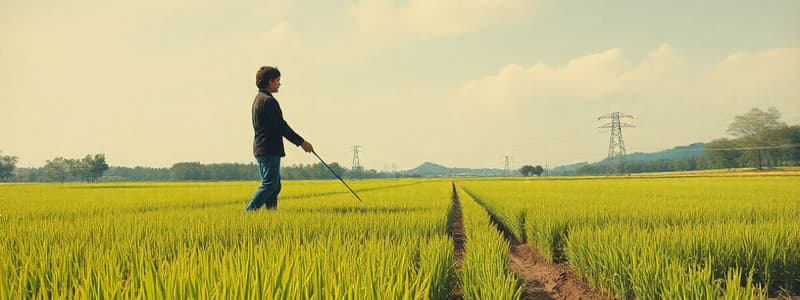Podcast
Questions and Answers
What is the role of photosynthesis in plants?
What is the role of photosynthesis in plants?
- To convert solar energy into chemical energy (correct)
- To release carbon dioxide and water
- To break down carbohydrates
- To synthesize proteins from amino acids
Which process involves breaking down large molecules to release energy?
Which process involves breaking down large molecules to release energy?
- Metabolism
- Photosynthesis
- Catabolism (correct)
- Anabolism
What percentage of protein is typically found in rice?
What percentage of protein is typically found in rice?
- 5%
- 15%
- 10% (correct)
- 20%
How do rice roots survive in submerged conditions?
How do rice roots survive in submerged conditions?
What is the consequence of modern milling processes on rice?
What is the consequence of modern milling processes on rice?
In oxidation-reduction reactions, what occurs during oxidation?
In oxidation-reduction reactions, what occurs during oxidation?
What is primarily produced during cellular respiration?
What is primarily produced during cellular respiration?
Which statement correctly defines metabolism?
Which statement correctly defines metabolism?
What is the primary function of photosynthesis in the biosphere?
What is the primary function of photosynthesis in the biosphere?
Which portion of the electromagnetic spectrum can be detected by the human eye?
Which portion of the electromagnetic spectrum can be detected by the human eye?
What happens to photons in the visible light range during photosynthesis?
What happens to photons in the visible light range during photosynthesis?
How does the energy of a photon relate to its wavelength?
How does the energy of a photon relate to its wavelength?
Which type of radiation has too much energy to be useful in photosynthesis?
Which type of radiation has too much energy to be useful in photosynthesis?
What is the lowest energy state that an electron can occupy called?
What is the lowest energy state that an electron can occupy called?
What role does visible light play in the process of photosynthesis?
What role does visible light play in the process of photosynthesis?
Which of the following statements about longer wavelengths is true?
Which of the following statements about longer wavelengths is true?
What happens to an electron when it absorbs a photon?
What happens to an electron when it absorbs a photon?
Where does photosynthesis primarily take place in plants?
Where does photosynthesis primarily take place in plants?
What is the primary function of chlorophyll in photosynthesis?
What is the primary function of chlorophyll in photosynthesis?
What do carotenoids do in the process of photosynthesis?
What do carotenoids do in the process of photosynthesis?
Which type of chlorophyll is primarily responsible for initiating photosynthesis?
Which type of chlorophyll is primarily responsible for initiating photosynthesis?
What is the structure that surrounds the fluid-filled area called the stroma in chloroplasts?
What is the structure that surrounds the fluid-filled area called the stroma in chloroplasts?
Which light wavelengths do chlorophyll primarily absorb?
Which light wavelengths do chlorophyll primarily absorb?
What is the role of stomata in mesophyll cells?
What is the role of stomata in mesophyll cells?
What is the primary role of chlorophyll in photosynthesis?
What is the primary role of chlorophyll in photosynthesis?
Why does the action spectrum not exactly match the absorption spectrum of chlorophyll?
Why does the action spectrum not exactly match the absorption spectrum of chlorophyll?
In Engelmann’s experiment, what method was used to measure photosynthesis?
In Engelmann’s experiment, what method was used to measure photosynthesis?
What are the main raw materials required for photosynthesis?
What are the main raw materials required for photosynthesis?
During which stage of photosynthesis does ATP and NADPH get produced?
During which stage of photosynthesis does ATP and NADPH get produced?
What products are formed during the light-dependent reactions of photosynthesis?
What products are formed during the light-dependent reactions of photosynthesis?
What is the general equation for photosynthesis?
What is the general equation for photosynthesis?
Which of the following is true about accessory pigments?
Which of the following is true about accessory pigments?
Flashcards are hidden until you start studying
Study Notes
Rice as a Staple Food
- Rice (Oryza sativa) feeds half the world's population, predominant in Asia, Africa, and Latin America.
- It is a cereal crop like wheat and corn, cultivated for its dry seeds (fruits).
- Grown submerged in 10-15 cm of water, rice roots thrive in low oxygen environments where most crops fail.
- Contains approximately 10% protein; requires supplementation with meat, fish, or protein-rich plants for balanced diets.
- White rice, produced through milling that removes bran and germ, is less nutritious than brown rice.
Metabolism Overview
- Metabolism encompasses all chemical processes in a cell, divided into anabolic and catabolic reactions.
- Anabolic reactions (anabolism) store energy by synthesizing complex molecules from simpler ones (e.g., photosynthesis produces glucose).
- Catabolic reactions (catabolism) release energy by breaking down larger molecules into simpler components (e.g., cellular respiration converts glucose to CO₂ and water).
Oxidation-Reduction Reactions
- Oxidation-reduction (redox) reactions are vital in metabolism, involving electron transfer between molecules.
- Oxidation denotes electron loss, while reduction indicates electron gain; these processes are interlinked.
- In cells, hydrogen removal signifies oxidation, and hydrogen gain signifies reduction.
Photosynthesis Process
- Photosynthesis transforms solar energy into chemical energy, yielding carbohydrates and oxygen from water and carbon dioxide.
- Acts as the foundational energy cycle for the biosphere, essential for life and oxygen supply to non-photosynthetic organisms.
Light and Its Properties
- Visible light is part of the electromagnetic spectrum (380-760 nm) and is crucial for photosynthesis.
- Light behaves as both a wave (with wavelength) and a particle (photons); its energy inversely correlates with wavelength.
- Short wavelengths (e.g., violet) carry more energy, while long wavelengths (e.g., radio waves) lack sufficient energy for photosynthesis.
Electron Excitation Mechanism
- Electrons can be energized by absorbing photons, transitioning from a ground state to a higher energy level.
- Energized electrons either return to ground state, releasing energy as heat/light, or transfer to another molecule, contributing to photosynthesis.
Chloroplast Structure and Function
- Photosynthesis occurs in chloroplasts, predominantly in mesophyll cells, containing multiple chloroplasts for optimal light absorption.
- Chloroplasts consist of two membranes with an internal stroma housing enzymes for carbohydrate synthesis and thylakoids for pigment storage.
Chlorophyll and Pigments
- Chlorophyll absorbs blue and red light, reflecting green, which leads to the characteristic color of plants.
- Chlorophyll a is the primary pigment initiating photosynthesis; chlorophyll b and carotenoids serve as accessory pigments that broaden light absorption.
Action and Absorption Spectrum
- The absorption spectrum illustrates pigment light absorption; chlorophyll a and b have distinct absorption profiles.
- The action spectrum indicates the effectiveness of light wavelengths for photosynthesis, correlating with but not matching the absorption spectrum.
Engelmann’s Experiment
- Engelmann (1883) demonstrated photosynthesis action spectrum using the alga Spirogyra, tracking bacteria movement towards oxygen production in blue and red light, confirming chlorophyll's role.
Photosynthesis Chemical Equation
- The general photosynthesis equation: 6CO₂ + 12H₂O → C₆H₁₂O₆ + 6O₂ + 6H₂O.
- Carbon dioxide and water convert into glucose and oxygen using light energy; chlorophyll acts as a catalyst.
Energy Conversion and Stages of Photosynthesis
- Light energy absorbed by chlorophyll splits water into oxygen, electrons, and protons, aiding carbohydrate formation.
- Photosynthesis occurs in two stages: light-dependent reactions generate ATP and NADPH in thylakoid membranes, utilizing light energy.
Studying That Suits You
Use AI to generate personalized quizzes and flashcards to suit your learning preferences.




